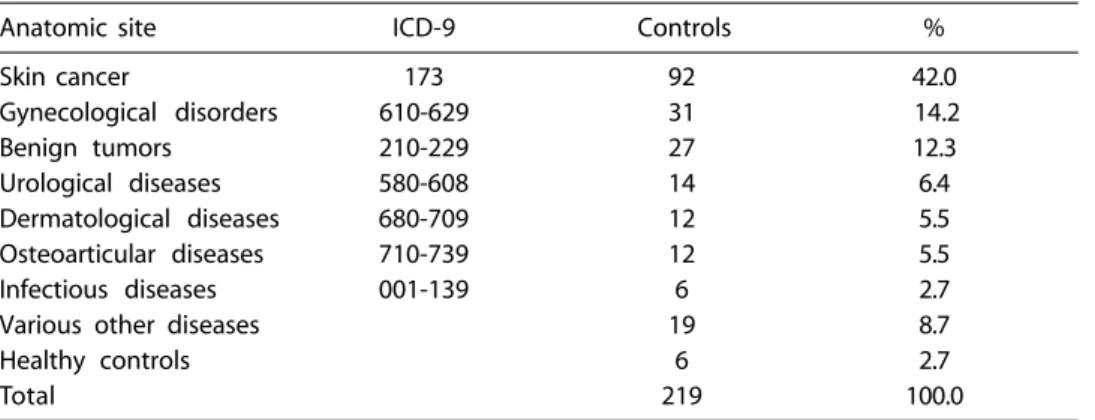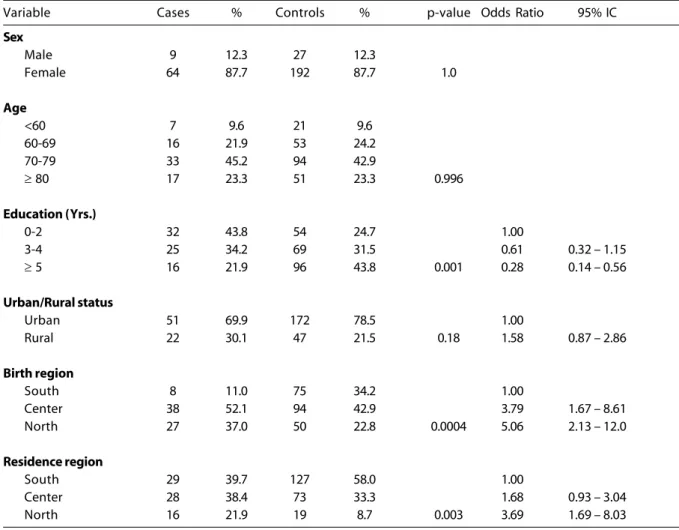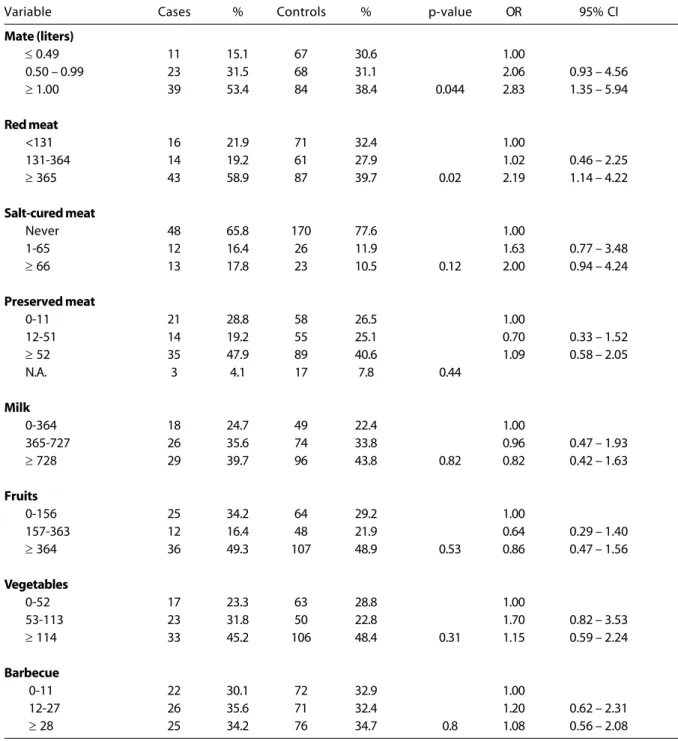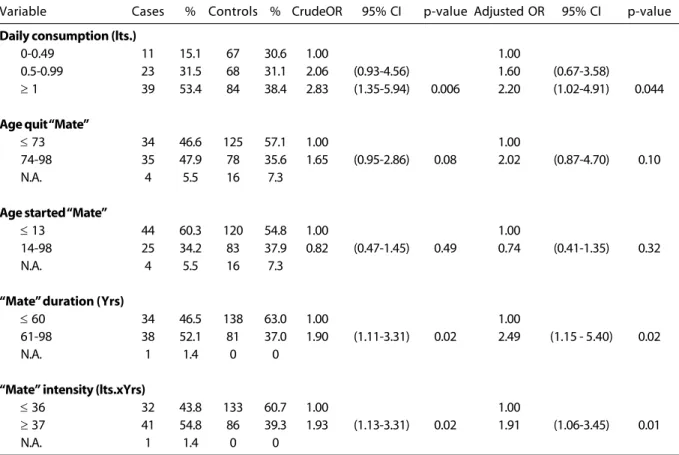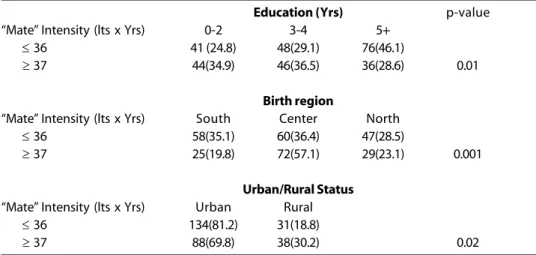Risk factors for esophageal cancer
in non-smokers and non-drinkers:
a case-control study in Uruguay
Fatores de risco para o câncer
esofágico em não usuários de
tabaco e bebida alcoólica: um
estudo caso-controle no Uruguai
Alvaro L. Ronco
Departamento de Epidemiología
Instituto de Radiología y Centro de Lucha Contra el Cáncer Hospital Pereira Rossell
Av. Centenario 2995 dep.403, Edif. Treviso
Montevideo 11600, Uruguay alronco@redfacil.com.uy
Enrique Barrios
Departamento de BiofísicaFacultad de Medicina, Montevideo, Uruguay Programa de Vigilancia Epidemiológica
Comisión Honoraria de Lucha contra el Cáncer, Uruguay
Luis Fierro
División de Epidemiología y Estadística
Instituto Nacional de Oncología, Montevideo, Uruguay
Julio Balbi
División de Epidemiología y Estadística
Instituto Nacional de Oncología, Montevideo, Uruguay
María T. Larrinaga
División de Epidemiología y Estadística
Instituto Nacional de Oncología, Montevideo, Uruguay
Eduardo De Stéfani
Registro Nacional de CáncerMinisterio de Salud Pública, Montevideo, Uruguay
Abstract
In order to analyze possible associations of lifestyle factors with esophageal cancer among non-smokers and non-drinkers, the authors carried out the present study. Spe-cial emphasis was placed on the analysis of “mate” (infusion of the herb Ilex paraguariensis) drinking, which has been as-sociated with most cancers of the upper aerodigestive tract. The study was conducted at the Instituto Nacional de Oncología in Montevideo, Uruguay. Data corresponded to 73 esophageal cancer cases and 219 con-trols. A detailed questionnaire included sec-tions on sociodemographic variables, occu-pation, family history of cancer, “mate” drinking, and a restricted list of dietary items including: red meat, processed meat, salted meat, barbecue, milk, fresh vegetables and fruits. Odds ratios (ORs) were estimated by unconditional logistic regression, adjusting for major potential confounders, including age, sex, education, urban/rural status and region of birth. Moderate increases in risk were observed for: daily “mate” consump-tion (OR=2.2), age of quitting (OR=2.02), du-ration (OR=2.49) and intensity (OR=1.91), most of which were statistically significant. Consequently, our report demonstrates a particular role for “mate” consumption on esophageal cancer in Uruguay, regardless of other well-known risk factors.
Key Words: Key Words: Key Words: Key Words:
Introduction
Esophageal cancer is a very frequent malignancy among the Uruguayan popula-tion, displaying an age-adjusted (world stan-dard population) incidence rate of 12.5 per 100,000 for men1, ranking 7th among men2.
“Mate”, the infusion of the herb Ilex paraguariensis, is a frequently consumed beverage in Uruguay, Argentina, Paraguay, and southern Brazil. A survey carried out in Uruguay showed that the local prevalence of “mate” consumption was 78%3. The
sur-vey also found a high correlation between “mate” consumption and smoking. Elevated alcohol consumption, low vegetable and fruit intake and smoking have been thoroughly investigated as factors associated with in-creased risk4-6. The relationship between
“mate” and esophageal cancer has also been extensively reported4-6. Previous reports on
“mate” and cancer in humans have showed increased risks for cancer in the esophagus, oropharynx, larynx and bladder5-9.
Research on esophageal cancer in non-smokers and non-drinkers has been particu-larly scarce10-12, and so far there have been
no reports on “mate” and esophageal can-cer in non-smokers and non-drinkers. Tak-ing into account the above mentioned high correlation between “mate” and tobacco consumption, and considering the difficul-ties for adequately controlling the confusion between these exposures, we decided to per-form the present study excluding smokers and drinkers from the analysis.
Subjects and Methods
In order to analyze possible associations of lifestyle factors with esophageal cancer among non-smokers and non-drinkers, the authors carried out a study during the pe-riod between 1/January/1988 and 18/April/ 2002. Four hundred and sixty-six (466) new cases of esophageal cancer were admitted for treatment at the Instituto Nacional de Oncología in the study period. Three hun-dred and fifty (350) individuals were inter-viewed by trained social workers, who were
Resumo
Os autores realizaram o presente estudo para analisar possíveis associações de fatores de estilo de vida com o câncer esofágico em não usuários de tabaco e bebida alcoólica. Foi especialmente enfatizada a análise do “mate” (infusão da erva Ilex paraguariensis), que tem sido associado à maioria dos cân-ceres do trato aerodigestivo. O estudo foi realizado no Instituto Nacional de Oncología em Montevidéu, Uruguai. Os dados corres-pondem a 73 casos de câncer esofágico e 219 controles. Um detalhado questionário incluiu seções de variáveis sócio-demo-gráficas, ocupação, história familiar de cân-cer, consumo de “mate” e uma relação res-tritiva de itens da dieta incluindo: carne ver-melha, carne processada, carne salgada, car-ne assada, leite, vegetais frescos e frutas. Os odd ratios (ORs) foram estimados com re-gressão logística incondicional, ajustados segundo os maiores potenciais fatores confundentes, incluindo a idade, o sexo, a educação, o estado urbano/rural e região de nascimento. Observaram-se acréscimos moderados no risco para: consumo diário de “mate” (OR=2.2), idade de abandono do consumo (OR=2.02), duração (OR=2.49) e intensidade (OR=1.91), a maioria dos quais foram estatísticamente significativos. Por conseguinte, nosso informe demonstra um rol particular para o consumo do “mate” no câncer esofágico no Uruguai, independen-temente de outros bem conhecidos fatores de risco.
Palavras-chave: Palavras-chave: Palavras-chave: Palavras-chave:
blind to major risk factors. No selection of cases was performed. Refusal to answer the questionnaire or severity of illness were the only reasons for not entering the study. All non-smokers and non-drinkers (73 cases, 20.9%) from the total were included in the study. Sixty-one cases (83.6%) were histologi-cally diagnosed with esophageal carcinoma. Of these, 50 cases were squamous cell type, 7 non-specified carcinomas, 2 adenocarcino-mas, and 2 were anaplastic types. The remain-der (12 cases, 16.4%) had an endoscopic diag-nostic base. Each case was frequency matched with 3 controls by age (+-5 years) and sex. Controls were randomly selected in each cat-egory, from a large database comprising all non-cancer patients and non-melanoma skin cancer patients, the latter usually showing epidemiological similarities with hospital con-trols. As a result, 219 controls were included in the study. All were patients seeking medical diagnosis and/or treatment at the same hos-pital during the same time period, and be-longed to the same population base, charac-terized mainly by low income, a low socio-cultural level and by being users of the public healthcare system. Conditions for control eli-gibility were to have a condition other than tobacco-alcohol related malignant tumors or digestive diseases. The distribution of controls is shown in Table 1.
A detailed questionnaire included sec-tions on sociodemographic variables, occu-pation, family history of cancer, “mate” drinking and a restricted list of dietary items
including: red meat, processed meat, salted meat, barbecue, milk, fresh vegetables, and fruits. Particular emphasis was placed on the consumption of “mate”, which was mea-sured as liters per day of the infusion, and its duration, intensity (liters per year), age that began drinking “mate” and age that quit drinking it. Answers were open-ended, al-lowing treatment of each food as a continu-ous variable13. Answers were converted to
times per year, multiplying by appropriate time units. All information collected was spe-cifically related to five years before the onset of symptoms of the disease which led to hos-pital admission.
Non-smokers were defined as individu-als who reported that they had never smoked 1 or more cigarettes/day for a continuous period of 1 year or more. Non-drinkers were defined as individuals who had never drank 1 cc per day of ethanol for a continuous pe-riod of 1 year or more.
Crude and adjusted Odds ratios (OR), as estimators of the relative risk (RR) for esoph-ageal cancer and the corresponding 95% confidence interval (CI) were estimated, the latter after adjustment for age (as a continu-ous variable), sex, education, urban/rural status and region of birth, by the Mantel and Haenszel method14. Univariate analyses were
performed in order to select relevant vari-ables to be considered for further regres-sion model building. Unconditional multiple logistic regression was subsequently used, fitted by the method of maximum
likeli-Table 1 - Distribution of controls.
Tabla 1 - Distribución de los controles.
Anatomic site ICD-9 Controls %
Skin cancer 173 92 42.0
Gynecological disorders 610-629 31 14.2
Benign tumors 210-229 27 12.3
Urological diseases 580-608 14 6.4
Dermatological diseases 680-709 12 5.5
Osteoarticular diseases 710-739 12 5.5
Infectious diseases 001-139 6 2.7
Various other diseases 19 8.7
Healthy controls 6 2.7
hood15. For multiple levels of exposure,
sig-nificance was assessed by tests for linear trend in risk15. In order to avoid statistical
instability, some estimations were performed on a dichotomist basis, using median values as the cut-off point. All calculations were performed with STATA statistical software16.
The referred questionnaire has been rou-tinely used for every patient admitted at the Instituto Nacional de Oncología with the ap-proval of the institution’s management, since 1988. For this reason, the study did not re-quire the intervention of a Bioethical Com-mittee. Nevertheless, the authors have re-cently submitted the study to an Ethics Com-mittee at the Uruguayan School of Medicine
of the State University, which approved the study design a posteriori. Finally, the authors recognize no interest of conflict related to the present study.
Results
Table 2 shows the results of the univariate analyses performed on the sociodemo-graphic variables. Females account for 87.7 %. Cases were significantly less educated than controls. Cases and controls also showed sig-nificant differences concerning regions of birth and residence. Moreover, rural status seemed to be linked to the disease, but dif-ferences were not significant. While region
Table 2 - Distribution of cases and controls according to sociodemographic covariates. Crude Odds Ratios for esophageal cancer estimated after univariate analysis.
Tabla 2 - Distribución de casos y controles según variables sociodemográficas. Odds Ratios crudos para cáncer esofágico estimados
luego de análisis univariados.
Variable Cases % Controls % p-value Odds Ratio 95% IC
Sex
Male 9 12.3 27 12.3
Female 64 87.7 192 87.7 1.0
Age
<60 7 9.6 21 9.6
60-69 16 21.9 53 24.2
70-79 33 45.2 94 42.9
≥ 80 17 23.3 51 23.3 0.996
Education (Yrs.)
0-2 32 43.8 54 24.7 1.00
3-4 25 34.2 69 31.5 0.61 0.32 – 1.15
≥ 5 16 21.9 96 43.8 0.001 0.28 0.14 – 0.56
Urban/Rural status
Urban 51 69.9 172 78.5 1.00
Rural 22 30.1 47 21.5 0.18 1.58 0.87 – 2.86
Birth region
South 8 11.0 75 34.2 1.00
Center 38 52.1 94 42.9 3.79 1.67 – 8.61
North 27 37.0 50 22.8 0.0004 5.06 2.13 – 12.0
Residence region
South 29 39.7 127 58.0 1.00
Center 28 38.4 73 33.3 1.68 0.93 – 3.04
of birth and region of residence displayed positive significant associations, education showed an inverse association with the risk of esophageal cancer.
Table 3 shows the distribution of foods and food groups. There was a significant dif-ference regarding meat consumption be-tween cases and controls (p=0.02). Salt-cured
Table 3 - Univariate analysis of selected “mate” and dietary covariates.
Tabla 3 - Análisis univariado de variables selectas de “mate” y dietarias.
Variable Cases % Controls % p-value OR 95% CI
Mate (liters)
≤ 0.49 11 15.1 67 30.6 1.00
0.50 – 0.99 23 31.5 68 31.1 2.06 0.93 – 4.56
≥ 1.00 39 53.4 84 38.4 0.044 2.83 1.35 – 5.94
Red meat
<131 16 21.9 71 32.4 1.00
131-364 14 19.2 61 27.9 1.02 0.46 – 2.25
≥ 365 43 58.9 87 39.7 0.02 2.19 1.14 – 4.22
Salt-cured meat
Never 48 65.8 170 77.6 1.00
1-65 12 16.4 26 11.9 1.63 0.77 – 3.48
≥ 66 13 17.8 23 10.5 0.12 2.00 0.94 – 4.24
Preserved meat
0-11 21 28.8 58 26.5 1.00
12-51 14 19.2 55 25.1 0.70 0.33 – 1.52
≥ 52 35 47.9 89 40.6 1.09 0.58 – 2.05
N.A. 3 4.1 17 7.8 0.44
Milk
0-364 18 24.7 49 22.4 1.00
365-727 26 35.6 74 33.8 0.96 0.47 – 1.93
≥ 728 29 39.7 96 43.8 0.82 0.82 0.42 – 1.63
Fruits
0-156 25 34.2 64 29.2 1.00
157-363 12 16.4 48 21.9 0.64 0.29 – 1.40
≥ 364 36 49.3 107 48.9 0.53 0.86 0.47 – 1.56
Vegetables
0-52 17 23.3 63 28.8 1.00
53-113 23 31.8 50 22.8 1.70 0.82 – 3.53
≥ 114 33 45.2 106 48.4 0.31 1.15 0.59 – 2.24
Barbecue
0-11 22 30.1 72 32.9 1.00
12-27 26 35.6 71 32.4 1.20 0.62 – 2.31
≥ 28 25 34.2 76 34.7 0.8 1.08 0.56 – 2.08
Unless otherwise indicated, all intake frequencies are expressed in servings per year. The NA category was not considered for the regression model; it is included only to complete the data presented.
meat intake displayed non-significant differ-ences, albeit this could be related to its low prevalence of consumption. The other foods analyzed did not show significant differences. Several models, including all referred covariates, were tested using unconditional logistic regression analysis. Only variables related to “mate” consumption remained statistically significant after adjustment and were therefore included in the final model. Results of the best fitted model are displayed in Table 4. Cases tended to be more exposed than controls, regarding daily consumption in liters (p=0.04), duration in years (p=0.02), age that quit drinking “mate” (p=0.10) and intensity in liters per year (p=0.03). These variables showed moderate positive associa-tions to risk of esophageal cancer.
Table 5 shows the distribution of “Mate” Intensity by some socio-demographic
vari-ables (education level, urban-rural status and region of birth).
Discussion
Our paper supports the hypothesis that a high consumption of “mate” increases the risk of esophageal cancer among non-smok-ers and non-drinknon-smok-ers.
Comparisons between crude and ad-justed Odds Ratios for “mate” covariates re-vealed a consistent decrease for the latter, according to the relevant role of selected adjustment covariates.
The IARC monograph had classified hot “mate” drinking as probably carcinogenic to humans (group 2) and recommended, be-fore reaching a more conclusive result, solv-ing the followsolv-ing issues: a) recall bias (i.e. awareness that “mate” drinking may increase
Table 4 - Results of unconditional logistic regression model for “mate” related covariates (*).
Tabla 4 - Resultados del modelo de regresión logística incondicional para variables relacionadas con “mate” (*)
Variable Cases % Controls % CrudeOR 95% CI p-value Adjusted OR 95% CI p-value
Daily consumption (lts.)
0-0.49 11 15.1 67 30.6 1.00 1.00
0.5-0.99 23 31.5 68 31.1 2.06 (0.93-4.56) 1.60 (0.67-3.58)
≥ 1 39 53.4 84 38.4 2.83 (1.35-5.94) 0.006 2.20 (1.02-4.91) 0.044
Age quit “Mate”
≤ 73 34 46.6 125 57.1 1.00 1.00
74-98 35 47.9 78 35.6 1.65 (0.95-2.86) 0.08 2.02 (0.87-4.70) 0.10
N.A. 4 5.5 16 7.3
Age started “Mate”
≤ 13 44 60.3 120 54.8 1.00 1.00
14-98 25 34.2 83 37.9 0.82 (0.47-1.45) 0.49 0.74 (0.41-1.35) 0.32
N.A. 4 5.5 16 7.3
“Mate” duration (Yrs)
≤ 60 34 46.5 138 63.0 1.00 1.00
61-98 38 52.1 81 37.0 1.90 (1.11-3.31) 0.02 2.49 (1.15 - 5.40) 0.02
N.A. 1 1.4 0 0
“Mate” intensity (lts.xYrs)
≤ 36 32 43.8 133 60.7 1.00 1.00
≥ 37 41 54.8 86 39.3 1.93 (1.13-3.31) 0.02 1.91 (1.06-3.45) 0.01
N.A. 1 1.4 0 0
the risk for cancer could have led to increased reporting of “mate” drinking for cancer cases as compared with controls); b) confirmation of the mate-cancer relationship by other groups of investigators; and c) exclusion of the possibility of residual confounding by tobacco smoking and alcohol drinking17. In
order to avoid this residual confounding, our study population was restricted to non-drinkers and non-smokers.
Concerning recall bias, differential re-porting by cases and controls is not likely in the present study, because no association between risk of esophageal cancer and “mate” drinking has been reported to date. On the contrary, the consumption of “mate” is popularly considered as a healthy infusion. As in developed countries, high con-sumption of alcohol and of tobacco are the major risk factors for esophageal cancer in Uruguay18,19. Low fruit and vegetable intake
has also been shown as a strong risk factor20.
The anti-carcinogenic factors found in those foods include ascorbic acid, vitamin E, caro-tenoids, flavonoids, phytosterols, indoles, fi-ber, among others21. Moreover, a larger
con-sumption of vegetables and fruits may be an expression of a more generally healthy atti-tude towards diet and other lifestyle habits. Uruguay is a country with recognized regional differences, concerning the spatial
Table 5 - Consumption of “Mate” according to socio-demographic variables (*).
Tabla 5 - Consumo de mate según variables sociodemográficas (*).
Education (Yrs) p-value
“Mate” Intensity (lts x Yrs) 0-2 3-4 5+
≤ 36 41 (24.8) 48(29.1) 76(46.1)
≥ 37 44(34.9) 46(36.5) 36(28.6) 0.01
Birth region
“Mate” Intensity (lts x Yrs) South Center North
≤ 36 58(35.1) 60(36.4) 47(28.5)
≥ 37 25(19.8) 72(57.1) 29(23.1) 0.001
Urban/Rural Status
“Mate” Intensity (lts x Yrs) Urban Rural
≤ 36 134(81.2) 31(18.8)
≥ 37 88(69.8) 38(30.2) 0.02
(*) One case classified as NA for “Mate” intensity has been excluded. / Se excluyó un caso clasificado como NA en la intensidad de “mate”.
distribution of poverty22. The Southern and
Southwestern regions are more developed; an ascending gradient of poverty is found when moving towards the North and North-eastern areas. The most critical situation is found for the political regions on the border with Brazil (our Region labeled “North”), where most people have one or more “un-satisfied basic need” (access to drinking wa-ter, to healthcare systems, to electricity, etc), that is, where living conditions are notably worse than in other zones of the country23.
Related to these facts, Table 5 shows that a lower consumption of “Mate” is associated with higher levels of education, urban status and southern birth regions.
due to the nature and number of patients admitted at the study institution, and we rec-ognize this limitation for the present analysis. At any rate, regression models included these terms in adjustments, in order to avoid con-fusion as much as possible.
Furthermore, Uruguay has the highest per capita meat intake in the world24. The lower
socioeconomic strata of the Uruguayan popu-lation are also high red meat consumers, as a consequence of the relatively low domestic prices and high availability of this primary product of Uruguay. Therefore, meat con-sumption is not an indirect indicator of wealth status. Anyhow, the existence of other not analyzed potential risk factors which could be related to esophageal cancer cannot be precluded in the present paper.
The increased OR’s observed in digestive cancers have been attributed to thermal in-jury resulting from the hot temperature at which certain beverages (“mate”, tea) are usually drunk5,17,25, albeit other experiments
have focused on chemical injury17.
Experiments at the cellular level combin-ing exposure of “mate” and hyperthermia have not found mutagenic activity due to “mate” infusion, and the highest observed mutagenic rate corresponded to hyperther-mia25. A few years ago an international panel
of experts recognized that “mate” possibly increases the risk of esophageal cancer be-cause of the temperature at which it is con-sumed26.
The genotoxic activity of “mate” infusions in short-term tests has been also reported27.
Several analyses performed with “mate” have identified several substances in it, such as caf-feine, theobromin, clorogenic and ascorbic acid, among others17. Of particular interest
were the large amounts of benzopyrene found in several brands of “mate”17. In the only
ex-perimental study in animals performed to date, the use of tar from the “mate” leaf pro-cessing applied to the skin induced skin
carci-noma28. Caffeic acid, a clorogenic and
isoclorogenic acid precursor, is present in “mate” and has been considered as a possible carcinogen in humans29. Therefore, a series
of chemicals present in “mate” (i.e. caffeic acid, benzopyrene) could be responsible for the increased risks of esophageal cancer. Taking into account that Uruguayan inhabitants have an average annual consumption of 8 kilograms of Ilex paraguariensis (i.e. 45 milligrams of benzopyrene/year)5, an increased risk of
can-cer is biologically plausible.
In summary, this paper shows that “mate” is an independent risk factor for esophageal cancer, contributing to exclude the role of residual confounding due to al-cohol and tobacco consumption, according to the above quoted IARC’s recommenda-tion. The underlying mechanism, whether thermal injury and/or chemical carcinoge-nicity, still remains unclear. The conclusive role of low intake of vegetable and fruits also deserves further investigation.
References
1. Parkin DM, Whelan SL, Ferlay J, Raymond L, Young J (eds.). Cancer Incidence in five continents Vol.VII. IARC Sci. Publ. Nº143, Lyon: International Agency for Research on Cancer; 1997.
2. Vassallo JA, Barrios E, De Stéfani E, Ronco AL. II Atlas of Cancer Incidence in Uruguay 1996-1997. Montevideo: Comisión Honoraria de Lucha Contra el Cáncer; 2001. (in Spanish)
3. Comisión Honoraria de Lucha contra el Cáncer. Knowledge, believes, attitude and practices
concerning cancer. Montevideo: Comisión Honoraria de Lucha contra el Cancer; 1993. (in Spanish)
4. De Stéfani E, Barrios E, Fierro L. Black (air-cured) and blond (flue-cured) tobacco and cancer risk:
oesophageal cancer. Eur J Cancer 1993; 29(5): 763-6.
5. De Stéfani E, Muñoz N, Estève J, Vassallo A, Victora C, Teuchmann S. Maté drinking, alcohol, tobacco, diet and esophageal cancer in Uruguay. Cancer Res 1990; 50: 426-31.
7. De Stéfani E, Correa P, Oreggia F, Leiva J, Rivero S, Fernández G et al. Risk Factors for Laryngeal Cancer. Cancer 1987; 60: 3087-91.
8. De Stefani E, Correa P, Oreggia F, Deneo-Pellegrini H, Fernandez G, Zavala D et al. Black tobacco, wine and mate in oropharyngeal cancer. Rev Epidemiol Santé Publ 1988; 36: 389-94.
9. De Stéfani E, Correa P, Fierro L, Fontham E, Chen V, Zavala D. Black Tobacco, Mate and Bladder Cancer. A Case Control Study from Uruguay. Cancer 1991; 67: 536-40.
10. La Vecchia C, Negri E. The role of alcohol in
oesophageal cancer in non-smokers, and of tobacco in non-drinkers. Int J Cancer 1989; 43: 784-85.
11. Tavani A, Negri E, Franceschi S, La Vecchia C. Risk factors for esophageal cancer in lifelong non-smokers. Cancer Epidemiol Biomarkers & Prevention 1994; 3: 387-92.
12. Tuyns AJ. Oesophageal cancer in non-smoking drinkers and in non-drinking smokers. Int J Cancer 1983; 32: 443-4.
13. Willett W. Nutritional Epidemiology. New York: Oxford University Press; 1990. p 92-126.
14. Mantel N, Haenszel W. Statistical aspects of the analysis of data from retrospective studies of disease. J Natl Cancer Inst 1959; 22: 719-48.
15. Breslow NE, Day NE. Statistical methods in cancer research. Vol. I.: The analysis of case-control studies. IARC Sci. Publ. Nº 32. Lyon: International Agency for Research on Cancer; 1980.
16. STATA. STATA user’s guide and reference manual, Release 6. College Station, Texas: STATA Press; 1999.
17. IARC. Coffee, tea, mate, methylxanthines and methylglyoxal. Monographs on the evaluation of the carcinogenic risk of chemicals to humans, vol. 51. Lyon: International Agency for Research on Cancer; 1991.
18. Muir CS, McKinney PA. Cancer of the oesophagus: a global overview. Eur J Cancer Prev 1992; 1: 259-64.
19. Tuyns AJ. Alcohol and cancer. An instructive association. Br J Cancer 1991; 64: 415-6.
20. De Stéfani E, Oreggia F, Boffetta P, Deneo-Pellegrini H, Ronco A, Mendilaharsu M. Tomatoes, tomato-rich foods, lycopene and cancer of the upper aerodigestive tract: a case-control in Uruguay. Oral Oncol 2000; 36(1): 47-53.
21. World Cancer Research Fund. Food, Nutrition and the prevention of cancer: a global perspective. Washington DC: World Cancer Research Fund; 1997. p. 125.
22. Pellegrino A, González S. Demographic Atlas of Uruguay. Montevideo: Ed. Fin de Siglo; 1995. (in Spanish)
23. Calvo JJ. The unsatisfied basic needs in Uruguay. Montevideo: Ed. School of Social Sciences, University of the Republic; 2000. (in Spanish)
24. Food Agriculture Organization. Food Balance Sheets 1999. Rome: FAO; 1999.
25. Candreva EC, Keszenman DJ, Barrios E, Gelós U, Nunes E. Mutagenicity Induced by hyperthermia, hot mate infusion, and hot caffeine in Saccharomyces cerevisiae. Cancer Res 1993; 53: 5750-3.
26. World Cancer Research Fund. Food, nutrition and the prevention of cancer: a global perspective. Washington DC: World Cancer Research Fund; 1997. p.128.
27. Leitão AG, Braga RS, Fonseca CAS. Genotoxicity of natural products (studies with mate and guarana). J Braz Soc Toxicol 1991; 4: 35.
28. Roffo AH. Cancer producido por el alquitrán del mate. Bol Inst Med Expt Cancer 1941; 18(56): 5-20.
29. IARC. Some naturally occurring substances.
Monographs on the evaluation of the carcinogenic risk of chemicals to humans, vol. 10. Lyon: International Agency for Research on Cancer; 1976.
